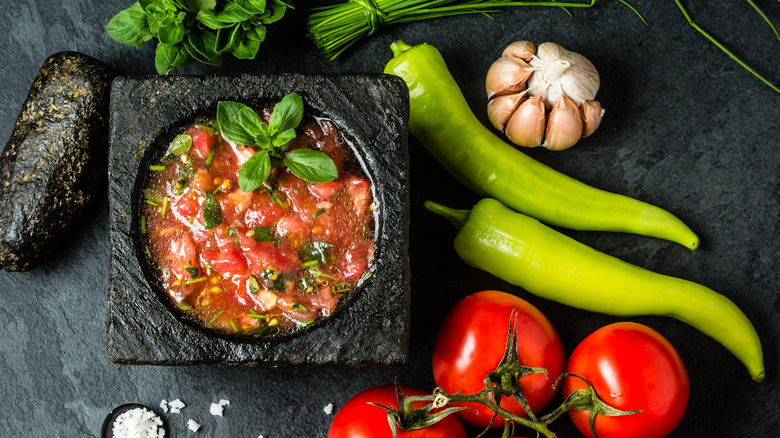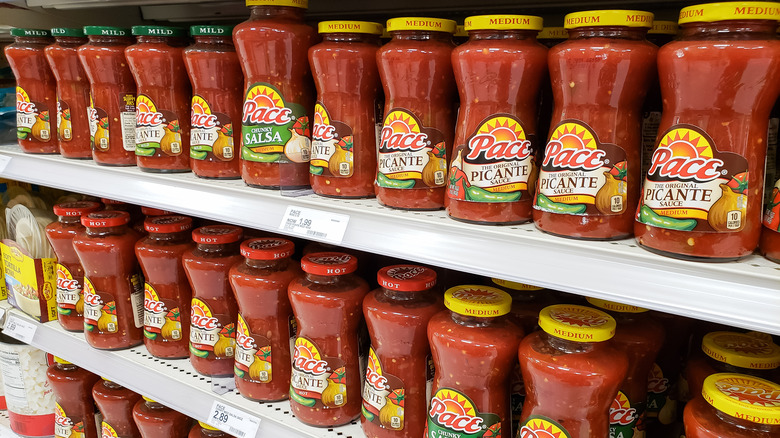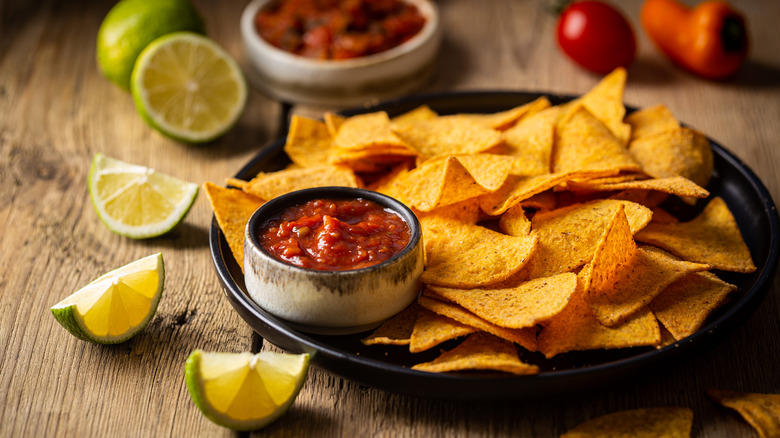How Salsa's Role Has Changed Over Time
Salsa has been elevating dishes and challenging tastebuds for thousands of years (per The Nibble). The spicy sauce has come a long way from its origins in ancient Mesoamerica to the Mexican food restaurant down the street, causing rifts between those who prefer authentic styles over Americanized Tex-Mex versions. Despite the debate over what makes a good salsa or how to use it, this popular condiment plays an important role in cuisines worldwide.
The Nibble notes that indigenous Central American cultures began domesticating wild chiles around 5200 B.C.E., followed by tomatoes in 3000 B.C.E, cultivating the foundational ingredients for what would one day become the world's most popular condiment. According to Food Editorial, the Aztec, Mayan, and Inca cultures are credited with creating the first salsa, which consisted of chiles, tomatoes, ground squash seeds, and spices. It was typically served alongside fish, meat, and game.
The first historical documentation of salsa came from Bernardino de Sahagún, a Franciscan missionary sent to work in the areas conquered by Hernando Cortes in 1529. Sahagún wrote about the flavorful sauces sold in the Aztec markets made from an array of chile peppers, herbs, beans, and avocados. Still, it wasn't until 1571 when Alonso de Molina, a Spanish priest and interpreter for Franciscan friars living in Mexico, gave the savory sauce enjoyed by generations of Central American cultures the name we know today.
Salsa evolves as it gains popularity
According to The Nibble, word of the spicy pepper and tomato-based sauce began slowly spreading into North America, where recipes and bottled sauces began appearing throughout the 1800s. Edward McIlheny used 350 empty cologne bottles to contain his Tabasco Sauce in the late 1860s, capturing the attention and tastebuds of cooks looking to spice up their dishes. Consumers who wanted to try out the buzzed-about peppery sauces would have to wait until 1916 when Charles E. Erath of New Orleans began manufacturing Extract of Louisiana Pepper Red Hot Creole Sauce on a commercial scale. La Victoria Foods began producing Salsa Brava one year later, and Baumer Foods came out with its famous Crystal Hot Sauce in 1928. These hot sauces helped introduce salsa to the masses while changing its role from a sauce to a condiment.
In 1941, Texans David and Margaret Pace of Pace Foods take salsa to a new level with a new creation: picante sauce. David Pace experimented with various techniques and combinations for "the better part of a decade" before landing on a chunky, medium-spicy version containing onion, jalapeño, and tomatoes that was a departure from the hotter and more fluid sauces on the market. Over the next few decades, brands like La Preferida and The El Paso Chile Company followed suit and began producing lines of salsas, some of which are still sold today. From 1985 to 1990, salsa sales increased by a whopping 79%, and in 1991 salsa knocked ketchup off its throne and took the title of America's favorite condiment.
There's a salsa for every taste
As salsa became globally beloved, The New York Times notes that its role changed and more variations on the standard salsa recipe came about. Mexican restaurants in Paris offer salsa made with cornichons and ketchup, while Americans added fruit, corn, and sweeteners that appealed to folks with a more timid palate. Salsa connoisseurs rolled their eyes at these new takes on their favored spicy sauce, and debates over authenticity ensued.
According to Vera Mexicana, tortilla chips played an important role in changing the way we salsa. Although its origin story is up for debate, the humble tortilla chip has partnered with salsa dating back to the early 1900s and is the preferred salsa consumption method for many. Although one salsa purist told The New York Times that "watching someone shovel in salsa with tortilla chips" reminds them of "watching someone drink salad dressing out of the bottle," that lasting trend is likely not going anywhere soon.
The role that salsa plays today is one that suits many fancies. If you want to snack on a bowl of peaches in sweet tomato sauce, there's a salsa for you. Use it as a sauce, dip, or condiment — it's your world. Salsa lovers seeking an authentic sauce don't have to solely swim through a sea of Tex-Mex versions, as restaurants and salsa producers now offer sophisticated blends of chiles, seeds, tomatillos, tomatoes, and spices that provide an unparalleled depth of flavor. Despite salsa's ever-changing role, there's no denying it has a fundamental place in our global cuisine.


